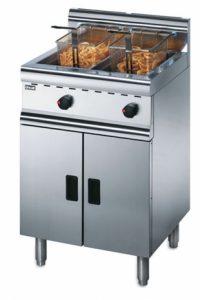

Commercial fryers can be a big investment for businesses
and so doing your research and making the right choice is
imperative. If you aim to serve the crispiest onion rings,
the perfect fried fish and the fluffiest chips, a quality fryer
is essential.
Choosing the best Commercial Fryer for your kitchen
Design
Power Supply
Capacity and Output
Operational Power
Number of Tanks
Sediment Zones
Accessories
Oil Filtration
Specialist Units
Controls
Which design works best for you?
- Countertop units – these compact units are designed to sit on existing work surfaces allowing smaller kitchens to offer fried foods even with limited space. A range of products are available with either single tanks, offering capacities of 3 litres to 20 litres or twin tanks, varying from 2 x 3 litres to 2 x 9 litres.
- Freestanding models – the ideal choice for larger kitchens that experience higher demand and therefore require increased output. Again these fryers are available with a choice of single or double tank design ranging from 8 litres to 40 litres or 2 x 8 litres to 2 x 17 litres respectively.
The design you decide on will largely depend on the size of your kitchen and the level of use you experience.
Power Supply; Electric or gas?
Commercial fryers can be powered by either gas or electric. Each has its own pros and cons therefore your final decision will typically be based on how you prefer to operate and the existing fittings you have in place. One area to consider is that although gas equipment may be more expensive to buy initially, it does tend to be cheaper to run on a day-to-day basis. Also note that a gas model may require a single phase electrical connection when a filtration system is present.
Capacity and Output
Capacity is typically displayed as the quantity of oil in litres that a tank can hold. With a wide range of sizes available, the perfect option for all requirements can be found whether equipment is in continuous use or only sees sporadic operation. The estimated output is difficult to gauge as this will often be dependent on the type of foods being fried (chips, chicken etc.), the state of the foods (chilled, frozen etc.), the coating (battered, crumbed etc.) and the quantity / portion sizes being prepared.
Operational Power
Power will often relate in some way to the size of the equipment. Larger units with higher capacity will often operate with higher power requirements. Increased power will lead to faster heat up times and speedier recovery* meaning that repeated use in a shorter time frame shouldn’t be an issue.
*Recovery refers to the length of time taken to achieve boiling point once chilled or frozen foods have been added to the oil.
Number of Tanks
Both countertop and freestanding designs are available with single or twin tanks. Twin tank fryers feature a permanent divide allowing a greater range of foods to be prepared simultaneously, even at different temperatures, without the risk of cross contamination. This double oil well layout also offers the added versatility of using both tanks during busy periods but operating only one when it’s quiet for optimum efficiency. Don’t assume that a single tank option only holds one frying basket. Some models with a single large oil tank are supplied with multiple baskets allowing more foods to be fried at once and proving useful when monitoring portion sizes.
Sediment Zone and Elements
All commercial fryers should have a sediment zone (sometimes called a cool zone). Any residue food, such as batter or crumbs for example, which break off during cooking collect here; the overall temperature being cooler than in the main frying area of the tank. It is worth bearing in mind that easy to access cool zones will make cleaning much simpler. If opting for an electric piece of equipment the base of each tank will have an element used to deliver heat to the oil. Consider whether your intended model offers hinged or lift out elements. This feature will allow in depth cleaning to be carried out with minimum obstruction.
Accessories
All commercial frying equipment, whether countertop or freestanding, should include at least one basket however additional baskets are usually available. Some models will also provide a batter plate to collect food debris for easy cleaning and a lid to cover the tank. Oil should always be covered when not in use not only for safety but also to protect against naturally occurring oxidisation which can reduce the lifespan of oil. All models will feature a drain of some sort to remove used oil when necessary. When opting for a freestanding unit, always check specifications to find out whether adjustable legs or castors are fitted as standard.
Oil Filtration
Some manufacturers will offer deep fryers with an inbuilt filtration system. While these products may have a higher initial outlay, potential future savings make the extra cost well worth it. By choosing a self-filtering unit you can enjoy reduced oil consumption and fewer oil changes. To find out more about the benefits of these models take a look at our ‘The Truth About Oil Filtration’ article.
Specialised Fryers
If serving specific products as opposed to general fried foods you may want to invest in a more specialised piece of equipment. Donut fryers are designed for countertop positioning and will generally offer a flat frying tray instead of a basket and a draining plate attached to the side of the tank to place doughnuts once removed from the fryer.
Controls
Whilst the majority of fryers operate with manual controls there are some that offer electronic operation. These often incorporate programmable cycles, countdown displays, alarms and timers for each tank; useful when continuous monitoring isn’t viable.


